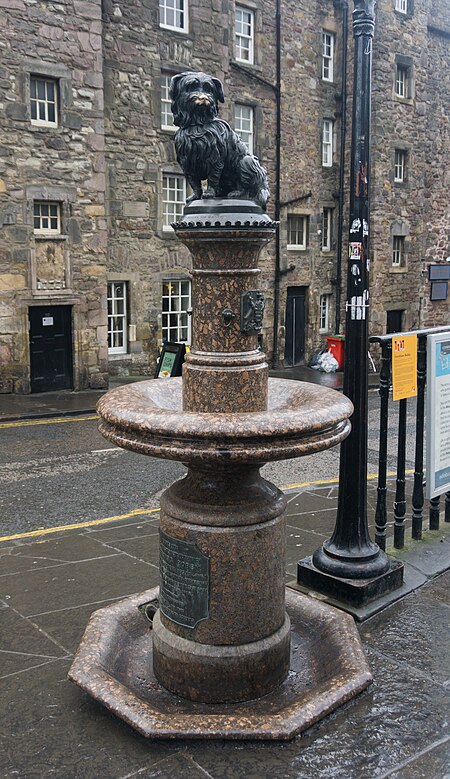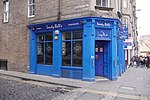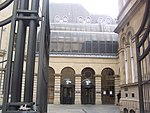Greyfriars Bobby Fountain

The Greyfriars Bobby Fountain is a granite fountain in Edinburgh, surmounted by a bronze life-size statue of Greyfriars Bobby, a Skye Terrier who became known in 19th-century Edinburgh for supposedly spending 14 years guarding the grave of his owner John Gray until the dog itself died on 14 January 1872. The memorial was commissioned by Lady Burdett-Coutts, president of the Ladies Committee of the RSPCA, shortly before the dog died, and the bronze statue was made from life by William Brodie. At the time, Brodie was making statues of characters from Walter Scott's Waverley novels for the Scott Monument in Princes Street. The statue is mounted on a polished column of granite, 3 feet (91 cm) high and 20 inches (51 cm) in diameter, above a polished granite basin 3 feet (91 cm) in diameter, mounted on a plinth, with an octagonal drinking trough at ground level. Bronze plaques are mounted on the column. The fountain was originally furnished with two bronze drinking cups which were attached to the column by a chain. The supply of water to the fountain was discontinued in 1957, and the monument suffered from neglect until it was restored in 1985. The memorial was sited at the southern end of George IV Bridge, just past its junction Chambers Street and close to the junction with Candlemaker Row, near the Greyfriars Kirkyard and the National Museum of Scotland. It was unveiled on 15 November 1873. The monument became a category A listed building in 1977. It is reputed to be Edinburgh's smallest listed building. The statue's nose has been a popular feature for tourists, believing that it brings "luck" if rubbed.
Excerpt from the Wikipedia article Greyfriars Bobby Fountain (License: CC BY-SA 3.0, Authors, Images).Greyfriars Bobby Fountain
Candlemaker Row, City of Edinburgh Old Town
Geographical coordinates (GPS) Address Website External links Nearby Places Show on map
Geographical coordinates (GPS)
| Latitude | Longitude |
|---|---|
| N 55.94695 ° | E -3.19132 ° |
Address
Greyfriars Bobby
Candlemaker Row
EH1 2QG City of Edinburgh, Old Town
Scotland, United Kingdom
Open on Google Maps









